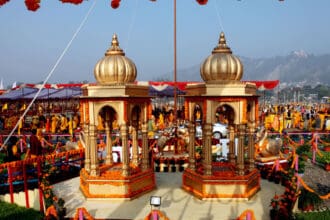The Golden Temple, also known as Harmandir Sahib, is the holiest shrine of Sikhism, located in the city of Amritsar, Punjab, India. The temple, with its glistening golden domes and sparkling pool, is an iconic symbol of the Sikh faith, attracting millions of devotees and visitors from all over the world. In this article, we will take a journey through the history, architecture, spirituality, and culture of the Golden Temple, exploring the intricate details and hidden gems that make it one of the most remarkable places on earth.
History of the Golden Temple
The history of the Golden Temple dates back to the 16th century when the first Sikh guru, Guru Nanak Dev Ji, visited Amritsar and was enchanted by the serene beauty of the place. The site of the temple was originally a small lake surrounded by a dense forest, where Guru Nanak used to meditate and teach his disciples. Over time, the lake became a popular spot for spiritual seekers, and a small community of devotees settled there, forming the foundation of the city of Amritsar.
The construction of the Golden Temple began in the late 16th century, under the guidance of the fourth Sikh guru, Guru Ram Das Ji, who envisioned a grand shrine that would serve as a center of worship and social justice for the Sikh community. The temple was built in the middle of the lake, with a causeway connecting it to the mainland, and was surrounded by a complex of buildings that served various purposes, including a community kitchen, a library, and a school.
Over the centuries, the Golden Temple has undergone numerous renovations and expansions, each adding to its grandeur and beauty. The most significant renovation was carried out in the 19th century, under the patronage of Maharaja Ranjit Singh, who covered the temple’s dome and walls with gold, giving it its iconic appearance and earning it the nickname “Golden Temple.”
Architecture and Design of the Golden Temple
The architecture and design of the Golden Temple reflect the Sikh philosophy of equality, simplicity, and harmony with nature. The temple is built on a square platform, symbolizing stability and balance, and is surrounded by a rectangular pool of water, called the Amrit Sarovar, which represents purity and eternity. The main entrance to the temple is through a massive gateway called the Darshani Deori, which leads to a causeway that spans the pool and connects to the temple’s main building.
The main building of the Golden Temple, also known as the Harmandir Sahib, is a two-story structure made of white marble and topped with glistening golden domes. The interior of the temple is decorated with intricate designs, including floral motifs, Islamic calligraphy, and Sikh symbols, and houses the sacred scripture of Sikhism, the Guru Granth Sahib.
The complex surrounding the Golden Temple includes several other buildings, including the Akal Takht, a five-story building that serves as the highest temporal seat of the Sikh religion, and the Guru Ram Das Niwas, a guesthouse for pilgrims.
Spirituality and Culture of the Golden Temple
The Golden Temple is not just a physical structure but a spiritual and cultural center that embodies the core values of Sikhism, including compassion, humility, and service to others. The temple is open to people of all faiths, and visitors are welcome to participate in the daily rituals and services, including the recitation of hymns, the washing of feet, and the sharing of meals.
One of the most remarkable aspects of the Golden Temple is the langar, or community kitchen, which serves free vegetarian meals to all visitors, regardless of their social or economic status The langar is a testament to the Sikh belief in the equality of all human beings and the importance of seva, or selfless service to others. Every day, thousands of volunteers work tirelessly to prepare and serve the langar, which can feed up to 100,000 people a day during peak periods. The langar is not just a place to eat but a place to connect with others, to share in the spirit of community and generosity that permeates the Golden Temple.
Another significant aspect of the Golden Temple is the tradition of kirtan, or devotional singing, which takes place throughout the day and night. The temple’s musicians and singers perform hymns from the Guru Granth Sahib, accompanied by the harmonious sounds of the tabla, harmonium, and other traditional instruments. The kirtan is a powerful experience that can transport visitors to a state of spiritual transcendence, connecting them with the divine and the inner self.
Apart from the spiritual significance, the Golden Temple is also a hub of cultural activity, showcasing the rich traditions and heritage of the Sikh community. The temple hosts various cultural events throughout the year, including festivals, exhibitions, and performances, which celebrate the diversity and creativity of the Sikh people. The temple’s museum, which displays rare artifacts and manuscripts related to Sikh history and culture, is also a must-visit for anyone interested in learning about the religion and its traditions.
Exploring the Golden Temple: Tips and Recommendations
Visiting the Golden Temple can be an overwhelming experience, with crowds of people, long queues, and a dizzying array of sights and sounds. Here are some tips and recommendations to help you make the most of your visit:
Getting There
The Golden Temple is located in the heart of Amritsar, about 13 kilometers from the airport and 2 kilometers from the railway station. Taxis, auto-rickshaws, and cycle-rickshaws are readily available, but it’s best to ask your hotel or guesthouse for advice on the most convenient and affordable mode of transport.
Dress Code
Visitors to the Golden Temple are required to cover their heads, remove their shoes, and dress modestly, as a mark of respect for the Sikh faith. It’s a good idea to bring a scarf or a hat to cover your head and wear comfortable, loose-fitting clothing that covers your arms and legs.
Timing
The Golden Temple is open 24 hours a day, seven days a week, and is busiest during the early morning and evening hours, when the rituals and services take place. If you want to avoid the crowds, try visiting during the mid-day hours or late at night.
Etiquette
While visiting the Golden Temple, it’s important to observe proper etiquette and respect the customs and traditions of the Sikh community. Avoid smoking, drinking, or eating non-vegetarian food within the temple complex, and refrain from taking photographs or using your phone during the services or ceremonies.
Conclusion
The Golden Temple is not just a physical structure but a living embodiment of the Sikh faith and its values. It is a place of spiritual and cultural significance that inspires awe, reverence, and humility in all who visit it. Whether you are a believer or a curious traveler, a visit to the Golden Temple is an experience that will stay with you for a lifetime.
FAQs
- Is the Golden Temple open to visitors of all faiths? Yes, the Golden Temple is open to people of all faiths. Visitors are welcome to participate in the daily rituals and services, regardless of their religious beliefs.
- Are there any specific dress codes for visitors to the Golden Temple? Yes, visitors are required to cover their heads and remove their shoes before entering the temple complex. It is also recommended to dress modestly and avoid wearing revealing or tight-fitting clothing.
- Can visitors participate in the langar, or community kitchen, at the Golden Temple? Yes, all visitors are welcome to participate in the langar and enjoy a free vegetarian meal.
- Are there any specific rules or guidelines for visitors while inside the Golden Temple complex? Yes, visitors are expected to maintain a respectful and peaceful demeanor while inside the temple complex. It is also recommended to avoid smoking, drinking alcohol, or engaging in any other behavior that may be considered disrespectful or inappropriate.
- Can visitors take photographs inside the Golden Temple complex? Yes, photography is allowed inside the temple complex, but visitors are requested to be respectful and mindful of their surroundings. It is also recommended to avoid taking photographs during prayer or other solemn moments.







